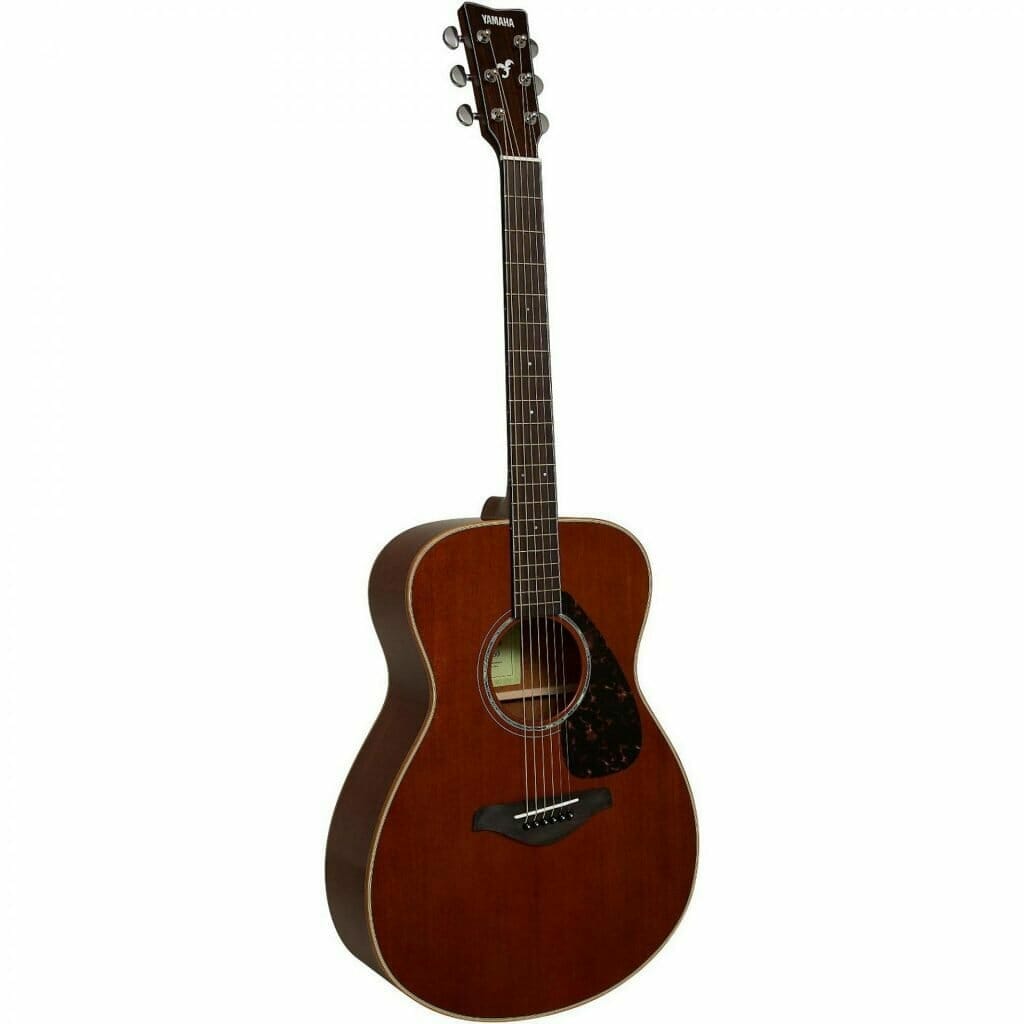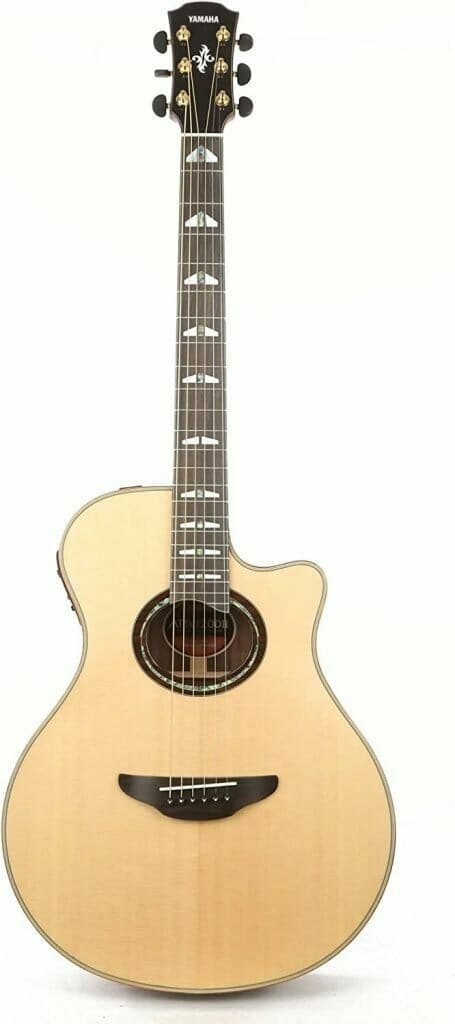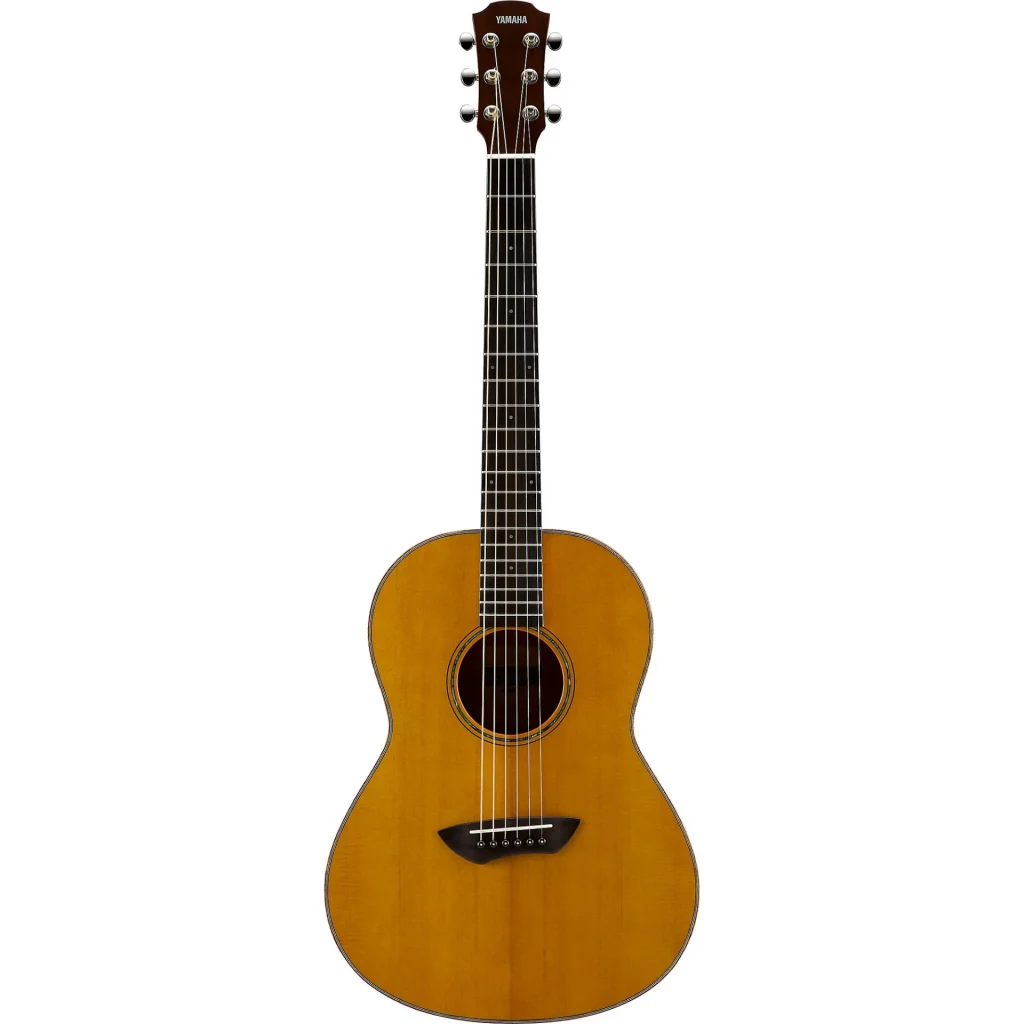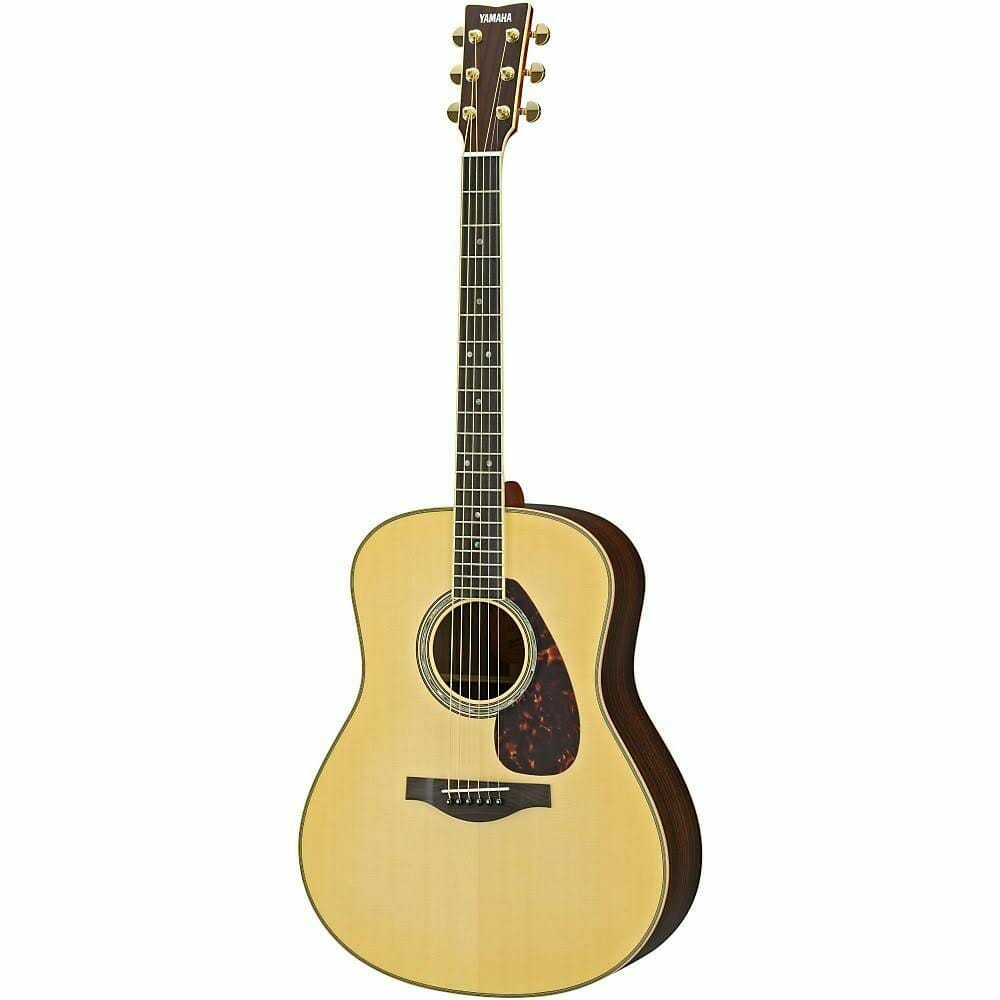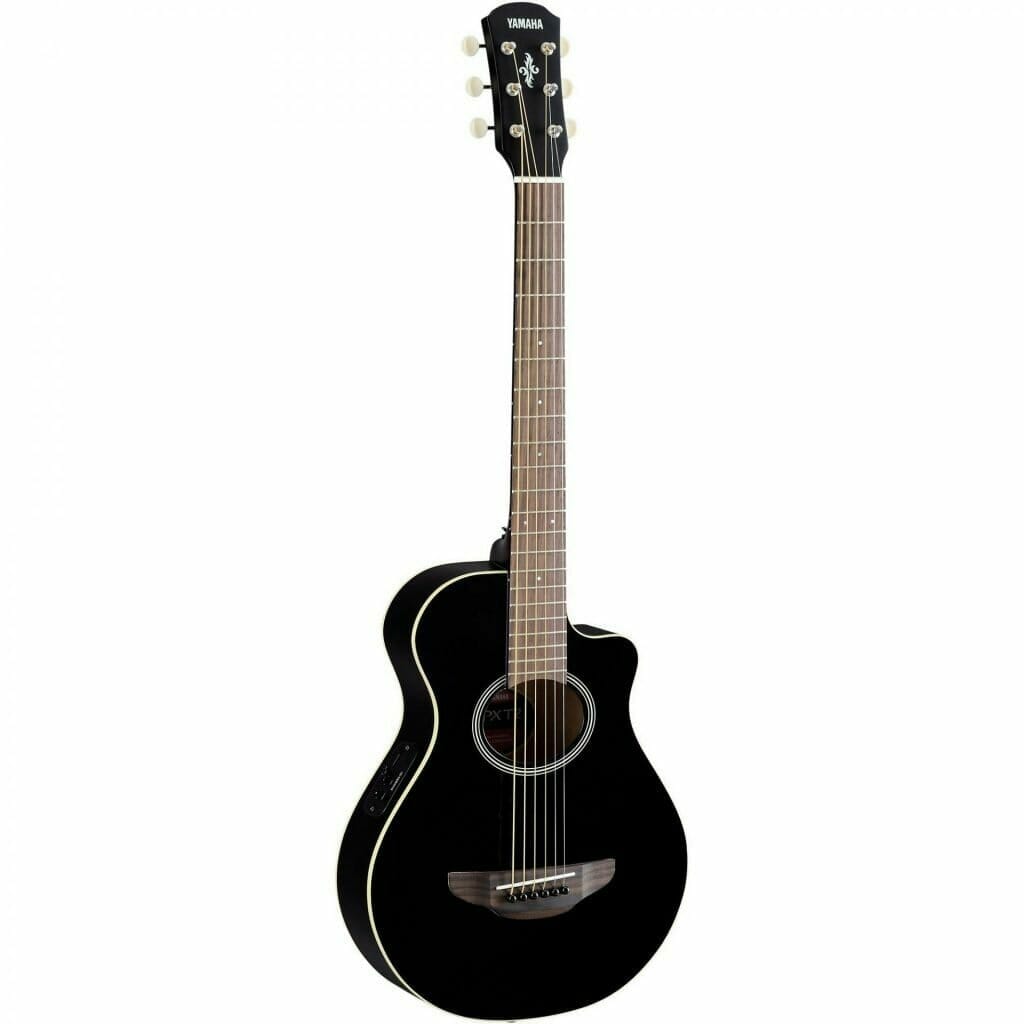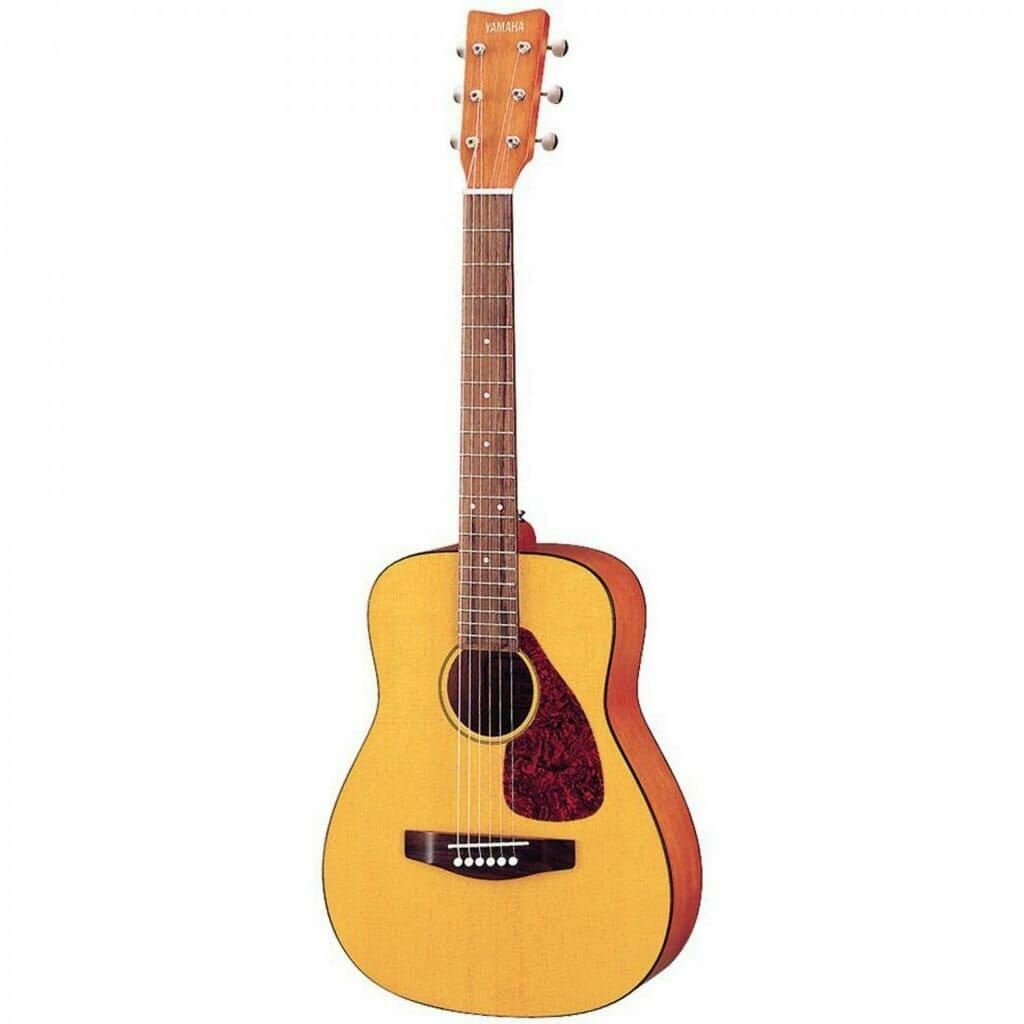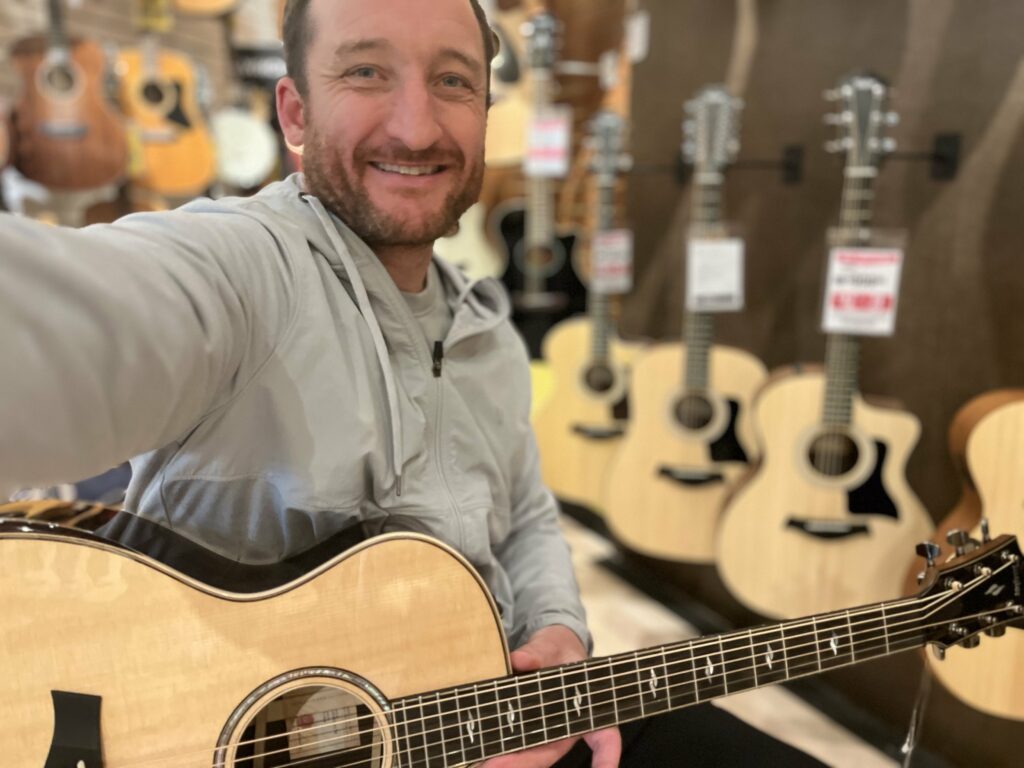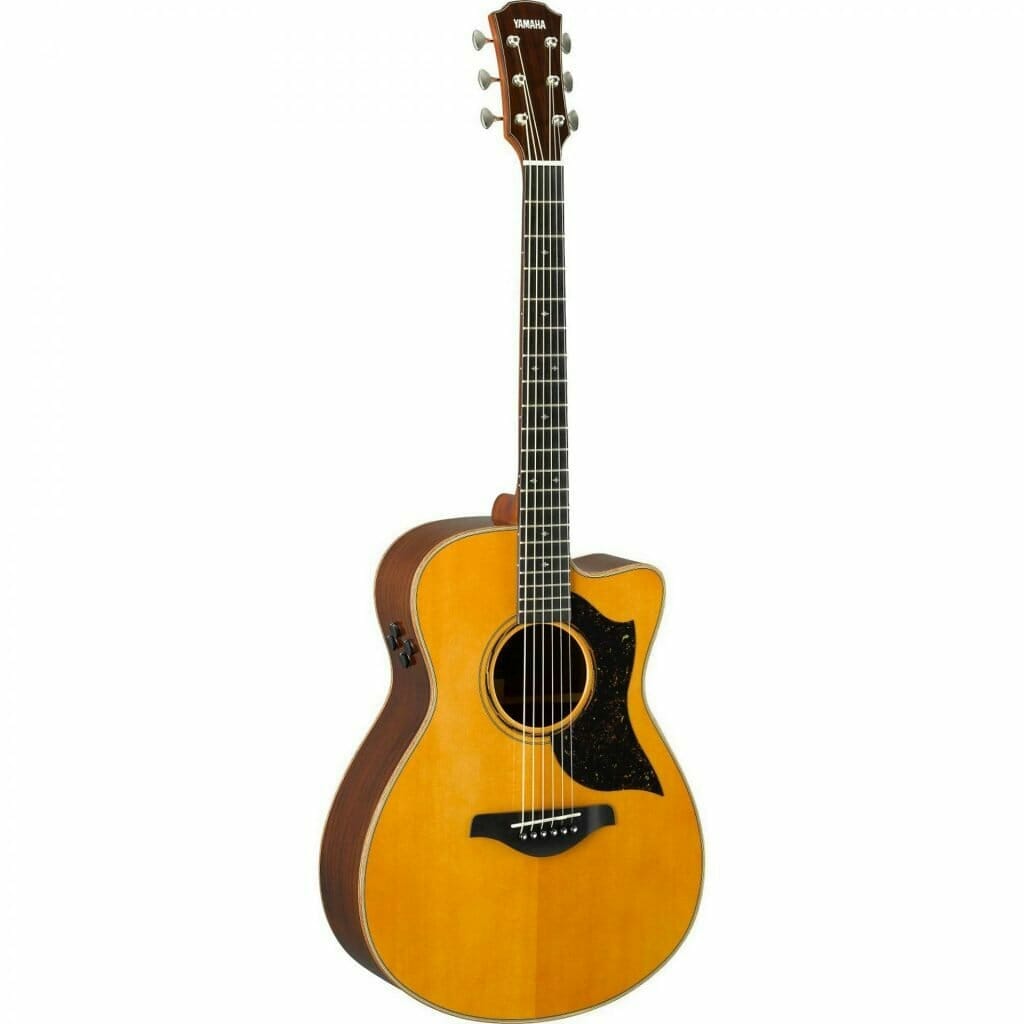
- Has an open, rich vintage tone from artificially aged wood that usually takes decades to achieve
- Build quality is excellent and utilizes classic tonewood materials
- Superb on-stage or in-studio acoustic guitar
- Hand-built in Yamaha's Japanese facility
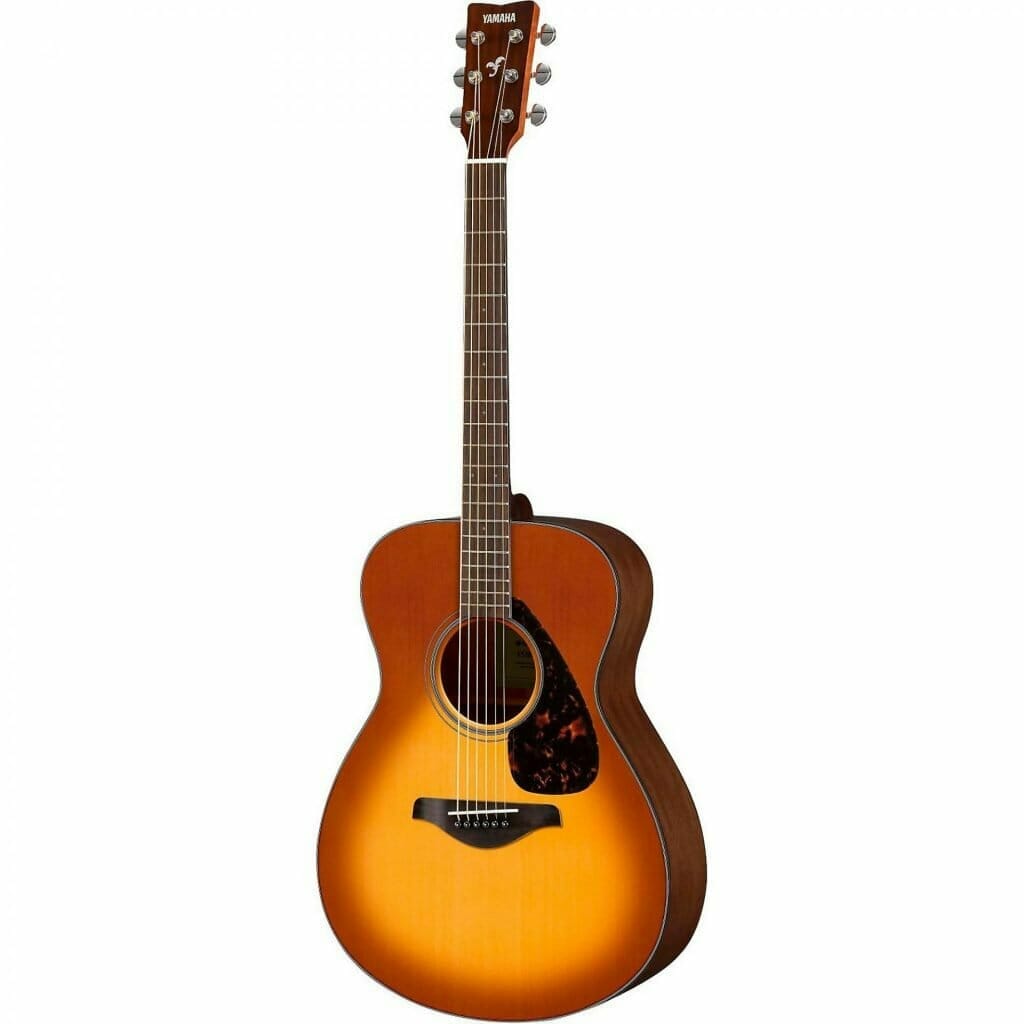
- It has a balanced, articulate, and intimate tone
- It's a pleasant playing experience, especially for those with tiny hands
- This guitar is an excellent value for the money
- It's one of the most beginner-friendly acoustic guitars available from any brand
Did you know that Yamaha makes high-quality, versatile Acoustic Guitars?
Do you want to find the best Yamaha acoustic guitar for your playing style and skill level? If so, then you’ve come to the right place.
From my 25+ years of experience playing guitar, I’ve concluded that for the price, construction, versatility, and tone, the AC5R is the best acoustic guitar Yamaha offers.
However, I understand that not every player is looking for the “swiss-army knife” guitar. Some might be looking for the best beginner guitar. So in this article, we will discuss the different acoustic guitars that Yamaha offers and which one might be the best fit for you.
So whether you’re a beginner just starting out or an experienced player looking for a new guitar, keep reading to learn more.
The Best Yamaha Acoustic Guitars in 2024 at a Glance
- Editors Choice:
AC5R - Best for Budget:
FS800 - Best for Recording:
FS850 - Best for Gigging:
APX1200II - Best for Fingerstyle:
CSF3M - Best for Flatpicking and Strumming:
LL16D ARE Original Jumbo - Best for Kids:
APXT2 3/4 Sized Guitar - Best for Travel:
JR Travel Guitar
With its solid tonewoods and premium build quality, the Yamaha AC5R Concert acoustic-electric guitar is perfect for players looking for an engaging and versatile instrument.
Handmade in Japan, this concert-sized guitar features a solid Sitka spruce top and solid rosewood back and sides, delivering a rich and dynamic tone. The Yamaha AC5R also benefits from Yamaha's wood torrefaction treatment, which gives the guitar top greater stability and a more authentic vintage vibe.
Plus, with Yamaha's versatile SRT2 pickup system, you'll be able to get a great tone no matter what situation you're in.
The Yamaha AC5R acoustic guitar has a lot to offer. It’s an all-solid-wood, hand-crafted Japanese instrument that sounds wonderful. It also costs about $1,000 less than comparable quality guitars from US-based guitar manufacturers.
This concert acoustic-electric guitar is light in your arms and produces a warm, rich sound. It’s very versatile and may be used by fingerstylists and strummers from all musical genres.
The artificially aged solid Sitka spruce top provides the guitar a rich, open sound that usually takes decades to achieve.
The build quality is excellent, utilizing classic tonewood materials. The back and sides are solid Indian Rosewood, the neck is African Mahogany, and it has a rosewood fingerboard.
The AC5R is also ready for the stage. It comes equipped with Yamaha’s distinctive SRT2 pickup system, which includes an under-saddle piezo pickup and two varieties of high-end microphone modeling you can blend between.
If you’re looking for the best Yamaha acoustic guitar for the money, quality, and tone, then the AC5R is a great buy!
- Excellent, hand-crafted guitar from Japan
- All solid wood design has a rich, open sound
- Extraordinarily versatile and can be used in studio or on-stage by all genres
- Yamaha's Acoustic Resonance Enhancement gives the guitar a vintage look and tone
- It's an expensive guitar
The Yamaha AC5R also made our top list of best acoustic guitars under $2,000. If your budget is between $1000 & $2,000, then you should check out the article here.
Packed with features and tone, the Yamaha FS800 Concert Acoustic is excellent for any player looking for an affordable acoustic guitar.
The solid spruce top gives you great projection and an impressive tone. While the smaller concert size is perfect for beginning and emerging players but is also popular among finger-pickers and recording artists.
So if you're looking for an affordable acoustic that sounds amazing, order your Yamaha FS800 today!
If you’re looking for the best acoustic guitar for beginners, then the FS800 should be on your shortlist.
The scalloped bracing and the solid spruce top provide a pleasant resonant, balanced sound that opens up over time. This is a highly comfortable guitar for all sorts of players, especially those with small hands, thanks to the tiny body, short-scale length, and slim neck design.
The concert body of the FS800 will create a more articulate and intimate tone. At the same time, the dreadnought version FG800 may be more to your liking if you’re searching for something with a louder, more projecting sound.
The drawbacks of this guitar are that it does not include any electronics, although the FSX800C model has them for a little more money.
All things considered, this is one of the most fantastic low-cost guitars available from any guitar brand today.
- It's one of the best acoustic guitars for beginners out of any brand
- It's a comfortable playing experience, especially for those with small hands
- The tone is articulate and intimate
- This guitar is an outstanding value for money
- The hardware used is lower quality
- Many users claimed the stock strings were low quality and need to be replaced immediately
Want to discover more options for the best budget acoustic guitars?
Check out my Best Acoustic Guitar Roundups for the following price ranges:
The Yamaha FS850 is the perfect instrument for any fingerstyle player.
This guitar was designed to project a naturally pleasing warm, worn-in tone. This is thanks to the mahogany design and smaller body style.
If you're looking for a guitar that will give your recordings something extra, look no further than the Yamaha FS850.
Lots of the guitars on this list will get you a good recording. However, specific guitars will make your life easier for quickly getting “radio-ready” guitar tracks.
I’ve discovered that an all Mahogany body records better than other tonewoods due to the naturally compressed sound of mahogany. This will help you record a more consistent and balanced track, which results in better headroom than a more dynamic tonewood such as spruce.
For this reason, I believe the Yamaha FS850 is the best Yamaha acoustic guitar for recording. It features an all Mahogany design, as well as a concert-sized body. This leads to a more focused, articulate, and intimate sound that will shine regardless of the microphone you use.
If you’re looking for a great affordable guitar that sounds great for your next acoustic guitar recording, the FS850 should be on your shortlist!
- Mahogany guitars will allow you to capture a more consistent and balanced recording
- It has a warm, rich vintage tone that sounds great in the studio
- Concert body shape has a comfortable feeling while playing
- The dark Mahogany wood is stunning and elegant
- The action might be too high for some players with the factory setup
- Doesn't come with a case or gig bag
Looking for an acoustic-electric guitar that's perfect for gigging? You need to check out the Yamaha APX1200II.
With its thinline cutaway body style, the APX1200II is lightweight and comfortable to play. But don't let its size fool you - this guitar packs a serious punch. Plus, the built-in Studio Response Technology (SRT) pickup and preamp provide studio-quality sound when you're plugged in.
Whether you're playing at home or on stage, the Yamaha APX1200II will exceed your expectations. /recommends/yamaha-apx1200ii/
There are three challenges guitar players face when playing acoustic guitar live:
- Recreating the natural sound of the guitar through amplification
- Playing an acoustic that doesn’t lose playability from weather changes during traveling
- Having a comfortable playing experience, especially when switching from playing an electric guitar
What makes the Yamaha APX1200II stand out is that its build is more like an electric guitar with a shallow, Thinline body style. It’s also incredibly lightweight and comes equipped with Yamaha’s SRT pickup technology and electronics, including a built-in tuner.
The SRT preamp allows you to blend in two different classic microphone signals to bring a studio-recorded sound to your live performances.
The solid spruce top, solid rosewood back and sides, ebony fingerboard, and mahogany neck is a classic, high-end tonewood combination. This will ensure your guitar sounds as good unplugged as it plugged in.
If you’re looking for a great stage guitar, then the Yamaha APX1200II won’t disappoint.
- The lightweight design is perfect for long performances
- The SRT pickup technology brings classic studio microphone sounds to your live performance
- It sounds just as good unplugged as it does plugged in
- The solid wood construction ensures that your guitar will only get better with time
- It's expensive
- For a guitar this price you would hope for a hardshell case to be included
Looking for an acoustic guitar with a rich, vintage tone? The Yamaha CSF3M is a perfect choice.
This parlor-style guitar has a mahogany back and sides, which give it a warm, mellow sound perfect for intimate fingerstyle playing.
Plus, its comfortable neck makes it easy to play. Don't miss out on this incredible instrument!
This parlor-sized guitar is a fantastic instrument for fingerstyle musicians with its solid Sitka spruce top, scalloped x-bracing, and solid mahogany back and sides.
The small body responds quickly to a light touch, and the shortened scale length (23.5″) provides a very “slinky” playability. This makes this steel-string acoustic have a more classical guitar feel.
This little guitar is also ideal for playing on the couch or around a bonfire. But this doesn’t mean the CSF3M’s can be great for performing at gigs. This guitar has Yamaha SRT pickup technology built-in, allowing you to take this wonderfully warm and intimate instrument to the stage without losing its charm.
If you’re searching for the best Yamaha acoustic guitar for intimate, fingerstyle playing, the CSF3M is an excellent option!
- Has a gorgeous tone that is perfect for intimate performances
- A high-quality instrument for a great price
- The shorter scale makes it easier to play fingerstyle music
- Ideal for taking to the beach or camping
- Users reported needing a professional setup after purchase
- Sensitive machine heads make it hard to tune accurately
This Yamaha guitar is a great choice for Fingerstyle. However, if you are looking to purchase a guitar specifically for fingerstyle, you should first read my article “The Best Fingerstyle Guitars for Acoustic Players and Songwriters”
Looking for a top-quality acoustic guitar that projects across a room? Yamaha's LL16D ARE Original Jumbo is a perfect choice.
This guitar brings the rich, warm sound of Engelmann spruce and solid rosewood for a top-quality instrument. This guitar feels and plays like a dream with a slimmer neck shape and enhanced fingerboard edge. And with the SRT Zero Impact Pickup, you'll be able to plug in and play with great tone wherever you go.
So if you're looking for a guitar that looks great and sounds great when strummed, the Yamaha LL16D ARE Original Jumbo is a great option!
The dreadnought-style acoustic guitar is often the best for loudness and projecting. While this is true, dreadnoughts often have a muddy mid-range. Switching between chords and lead-picking sections can result in a loss of clarity and note articulation.
This is where a Jumbo-bodied guitar shines. The larger body of a Jumbo guitar keeps the excellent projection of a dreadnought. Still, the more pinched-in waist results in a more focused and articulate sound that allows each note in a chord to sing.
The LL16D is a well-made, all-solid wood Jumbo-sized guitar from Yamaha that will appeal to any player seeking to fill a space with their music.
This acoustic guitar has a solid Engleman spruce top, solid rosewood back and sides, and a 5-ply Mahogany/Rosewood slim neck for great tone and excellent playability.
It also has a Yamaha SRT Zero Impact pickup system, allowing you to quickly bring the beautiful acoustic sound to the stage.
- The spruce is torrified and makes the guitar sound like it's decades-old
- Comes with a hardshell case
- Your chords will be more powerful with great articulation
- High quality, all solid wood construction
- On the expensive side for a Chinese manufactured guitar
- Not as expressive as other dreadnought guitars from other brands
The Yamaha APXT2 is an excellent acoustic-electric guitar for kids or anyone with smaller hands.
Based on the popular APX500, the APXT2 features a 3/4-size body and a System 68 contact pickup with an active preamp for great sound anywhere you go.
Plus, it comes with a padded gig bag, so you can take it with you on the go.
If you’re searching for a beginner guitar for a child, the Yamaha APXT2 is an excellent choice. This guitar is smaller than a regular guitar, making it very simple to play for little kids.
Yamaha’s APX body is slightly different from other acoustic-electric guitars on the market. Its design and features appeal to musicians who want an on-stage acoustic guitar that feels similar to their electric guitar. For this reason, I recommend the APXT2 for youngsters since it will assist them in making the transition to an electric instrument when they are ready.
This miniature guitar is incredibly affordable, versatile, and well-made. It also looks great, and your kiddo will undoubtedly fall in love with it at first sight!
- It makes a great gift for small children
- The guitar is lightweight, small, and easy to play
- It's affordable and versatile
- It comes with electronics and a built-in tuner, so it's ready to plug in and play
- Doesn't respond well to aggressive strumming or picking
- The overall tone is shallow and two-dimensional
If you’re in the market for a guitar for your kid, then you should check out my articles:
- The Best 1/4 Size Guitars for Toddlers (3-6) in 2024
- The Best 1/2 Size Guitar for Your Musical Kiddo (6-8) in 2024
- The 9 Best 3/4 Acoustic Guitars (8-12) in 2024
Looking for a travel-friendly guitar that doesn't sacrifice tone? Look no further than the Yamaha JR1.
This compact folk guitar is modeled after Yamaha's famous FG folk guitar series. It gives you a big acoustic sound in a smaller size package that is great for musicians on the go. It also comes with a traveling gig bag which is fantastic for a guitar at this price.
Ready to take your music anywhere? Grab a Yamaha JR1 and hit the road!
The Yamaha JR mini acoustic is excellent for the traveling nomad looking to save space while not sacrificing the vintage look of a dreadnought-style acoustic guitar.
This guitar is a miniature version of Yamaha’s classic FG (Folk Guitar) guitars. It’s a highly affordable guitar that plays and sounds good but won’t be the best guitar on this list.
This guitar comes with a gig bag and is ideal for stowing in the back of your car or throwing into your luggage.
- Great for small spaces and traveling
- Classic dreadnought style in a small package
- Great for traveling nomads
- Affordable guitar with good sound quality
- The tone is two dimensional and flat
- Users have noted that their guitar had some visible construction flaws
Have you ever wondered what the best guitar brands on the market are today? Well, I created an ultimate acoustic guitar brand guide and buyer’s guide to help you choose your perfect guitar. Check it out today!
The Bottom Line
Whether a beginner or a skilled player, the AC5R has something for everyone. With so many great features and a great tone, it is hard to find anything wrong with this guitar.
I hope my reviews and buying guide help with your decision-making when looking for the best Yamaha acoustic guitar for you.

- Has an open, rich vintage tone from artificially aged wood that usually takes decades to achieve
- Build quality is excellent and utilizes classic tonewood materials
- Superb on-stage or in-studio acoustic guitar
- Hand-built in Yamaha's Japanese facility

- It has a balanced, articulate, and intimate tone
- It's a pleasant playing experience, especially for those with tiny hands
- This guitar is an excellent value for the money
- It's one of the most beginner-friendly acoustic guitars available from any brand

